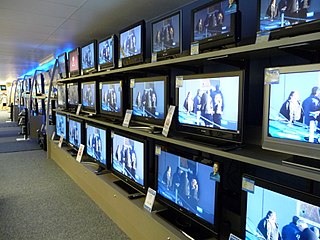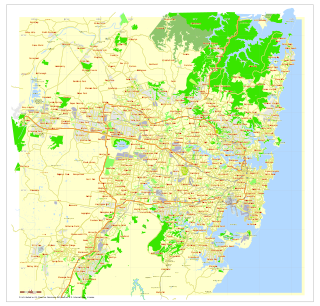This article includes a list of references, but its sources remain unclear because it has insufficient inline citations .(October 2010) (Learn how and when to remove this template message) |
| Emergency | |
|---|---|
| Genre | Drama |
| Starring | Brian James Syd Conabere Judith Godden Natalie Raine |
| Country of origin | Australia |
| Original language(s) | English |
| No. of seasons | 1 |
| No. of episodes | 16 |
| Production | |
| Production location(s) | Melbourne, Victoria |
| Running time | 24-26 minutes |
| Production company(s) | GTV-9 |
| Release | |
| Original network | Nine Network |
| Picture format | Black & White |
| Audio format | Mono |
| Original release | 16 February – 1 June 1959 |
Emergency is an Australian television series produced by GTV-9 in 1959.

Television (TV), sometimes shortened to tele or telly, is a telecommunication medium used for transmitting moving images in monochrome, or in color, and in two or three dimensions and sound. The term can refer to a television set, a television program, or the medium of television transmission. Television is a mass medium for advertising, entertainment and news.
Contents
The series was set in the busy casualty department of a major Melbourne hospital, and is notable for being one of the first-ever dramas shown on Australian television. [1]
Made by Melbourne's GTV-9 in co-operation with the Royal Melbourne Hospital, and based on Britain's Emergency Ward 10 , Emergency starred Brian James as Dr. Geoffrey Thompson, Syd Conabere as orderly George Rogers, and Judith Godden as Nurse Jill Adamson. Moira Carleton also featured as Matron Evans.

The Royal Melbourne Hospital (RMH), located in Parkville, Victoria, an inner suburb of Melbourne, is one of Australia’s leading public hospitals. It is a major teaching hospital for tertiary health care with a reputation in clinical research. The hospital is managed as part of Melbourne Health which comprises the Royal Melbourne Hospital, North West Dialysis Service and North Western Mental Health. The Melbourne Health Chief Executive is Christine Kilpatrick.
The series was produced primarily in the GTV-9 studio, with brief (usually pre-credit) exterior sequences shot on 35mm film by newsreel cameramen. The episodes were not broadcast live, but were kinescoped to meet programming requirements, and facilitate later screening in Sydney.

Kinescope, shortened to kine, also known as telerecording in Britain, is a recording of a television program on motion picture film, directly through a lens focused on the screen of a video monitor. The process was pioneered during the 1940s for the preservation, re-broadcasting and sale of television programmes before the use of commercial broadcast-quality videotape became prevalent for these purposes.

Sydney is the state capital of New South Wales and the most populous city in Australia and Oceania. Located on Australia's east coast, the metropolis surrounds Port Jackson and extends about 70 km (43.5 mi) on its periphery towards the Blue Mountains to the west, Hawkesbury to the north, the Royal National Park to the south and Macarthur to the south-west. Sydney is made up of 658 suburbs, 40 local government areas and 15 contiguous regions. Residents of the city are known as "Sydneysiders". As of June 2017, Sydney's estimated metropolitan population was 5,230,330 and is home to approximately 65% of the state's population.
The series' premise was simple: a basic dramatic exploration of cases passing through the Casualty ward. Scripts were written by GTV staffers Roland Strong (series producer) and Denzil Howson (series director) under pseudonyms.
Sponsorship came from British Petroleum, and a contract was signed for 52 half-hour episodes. The series debuted on GTV-9 on 16 February 1959, and on Sydney's ATN-7 a week later. Critics initially appeared fairly neutral, however a highly negative article on the series in a Sydney newspaper caused BP to withdraw sponsorship 16 weeks into the series run. Faced with having to carry the production expenses alone, GTV-9 discontinued production, with the final episode airing in Melbourne on 1 June 1959.

BP plc is a British multinational oil and gas company headquartered in London, United Kingdom. It is one of the world's seven oil and gas "supermajors", whose performance in 2012 made it the world's sixth-largest oil and gas company, the sixth-largest energy company by market capitalization and the company with the world's 12th-largest revenue (turnover). It is a vertically integrated company operating in all areas of the oil and gas industry, including exploration and production, refining, distribution and marketing, petrochemicals, power generation and trading. It also has renewable energy interests in biofuels and wind power.
Following the series demise, Brian James went on to lead roles in the ABC serial Stormy Petrel in 1960, and ATN-7's period drama Jonah in 1962, later appearing as George Tippit in the drama serial "Skyways" (1979–81).
Stormy Petrel was an early Australian television drama. A period drama, the 12-episode serial told the story of William Bligh and aired in 1960 on ABC.
ATN is the Sydney flagship television station of the Seven Network in Australia. The licence, issued to a company named Amalgamated Television Services, a subsidiary of Fairfax, was one of the first four licences to be issued for commercial television stations in Australia. It began broadcasting on 2 December 1956.
Jonah is an Australian television drama series which aired for 20 episodes starting from 15 October 1962 on the Seven Network. Produced during an era when commercial television in Australia produced few dramatic series, Jonah was a period drama, and was inspired by the success of ABC's period drama mini-series like Stormy Petrel. The episodes still exist.
Conabere and Carleton appeared in guest roles in most of the Australian TV dramas on the 1960s and 1970s.
